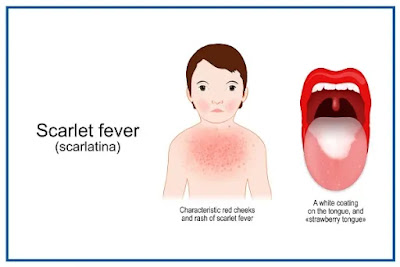One of the oldest infectious diseases is scarlet fever. It was seen as extremely terrifying and might have grave consequences even a century earlier. New methods for diagnosis and treatment are developed as medicine advances. Scarlet fever is not seen as serious today and is well tolerated.
The body of a kid is thought to be weaker and less able to resist infection, which is why it is thought that this sickness is childlike. Is adult scarlet fever a possibility? is an issue that sparks a lot of curiosity. It is important to remember that this condition is contagious, and germs do not care how old an organism is. Therefore, scarlet fever affects both children and adults.
Common symptoms of scarlet fever (Scarlatina):
Children who concurrently suffer from strep throat or strep skin infections might develop scarlet fever, often known as scarlatina. A bright red, bumpy rash is brought on by the toxin (poison) that the strep bacteria produce. The name "scarlet fever" comes from the widespread rash that covers the majority of the body.
1- Flu, sore throat, and chills.
2- Headache.
3- Vomiting.
4- Abdominal pain.
5- Coated tongue will be white.
6- The tongue is a strawberry-like color.
7- Rash that is red.
8- Having trouble swallowing.
Major causes of scarlet fever:
Scarlet fever is caused by the three toxins of group A Beta hemolytic streptococcal infection, which generally affects the throat but can affect other areas as well. It usually affects children aged 5 to 15, however, it can sometimes affect adults.
Antibodies to the toxins develop, thus the rash is less common with repeated strep infections. Furthermore, the toxins are strain-specific, and the intensity of the rash may differ. Pediatricians frequently detect step rashes, and the rashes usually only appear once or twice in the same person.
Why scarlet fever is less common nowadays?
Antibiotics appear to be the answer, at least in the Western world and many areas of Asia. Scarlet fever develops as a result of a streptococcal infection. In these areas, timely treatment with antibiotics as common as Penicillin cures the index case and prevents it from spreading to family and friends.
Nonetheless, whenever we try to minimize antibiotic use, red rash febrile children occasionally show up at the emergency department. Junior physicians have seldom encountered it, but veteran doctors recognize it at a glance.
Penicillin was once administered to everyone who had a sore throat. Perhaps some viral illnesses were "treated" with antibiotics that were unneeded. The authorities then sought to persuade doctors to only treat those who tested positive for strep. There has been a lot of pushback against unneeded antibiotics (but not for agricultural animals).
Of course, some strep tests came out negative. Even when they are sick, some people do not seek medical attention. Scarlet fever cases have increased from one in ten thousand to three in ten thousand every year.
Side effects of scarlatina:
Scarlet fever can cause throat enlargement, which can make breathing difficult. It can kill by developing septicemia, a blood infection. Its fever may cause severe dehydration, which can be fatal in newborns and young children.
Complications include heart muscle and mitral valve damage, a significant kidney illness (post-streptococcal glomerulonephritis), pneumonia, and meningitis, all of which can be potentially fatal.
How the scarlet fever cured in the early 1800s?
Scarlet fever was one of the most devastating epidemics of the nineteenth century. Isolation and escape of patients or those suspected of having the disease was also a dangerous profession. Those infected were transported in horse-drawn 'fever cabs' and held in isolation hospitals for weeks to prevent the sickness from spreading. All personal items were disposed of.
A strict diet was also suggested to avoid eating animal products, drinking alcohol, and using spices. Mothers and older female children were assigned to keep a watchful eye on the ill youngsters. As a result, female family members suffered with such additional obligations outside of maintaining a household. I hope this provides a contrast between contemporary medicine at the time and modern medicine in the twenty-first century. I believe the sole reason for blood letting now is so that people may donate blood, but it is still a version of the practise.
When a patient was diagnosed with scarlet fever, the most frequent therapy at the time was donating blood. The use of blood as a medicinal practice was used in numerous civilizations as early as the fifth century BC. This practice was thought to be rational at the time since the foundations of medical therapy were based on the theory that sickness is caused by an imbalance of blood, phlegm, yellow bile, or black bile. To restore equilibrium, purging, fasting, vomiting, and bloodletting were to be used.


